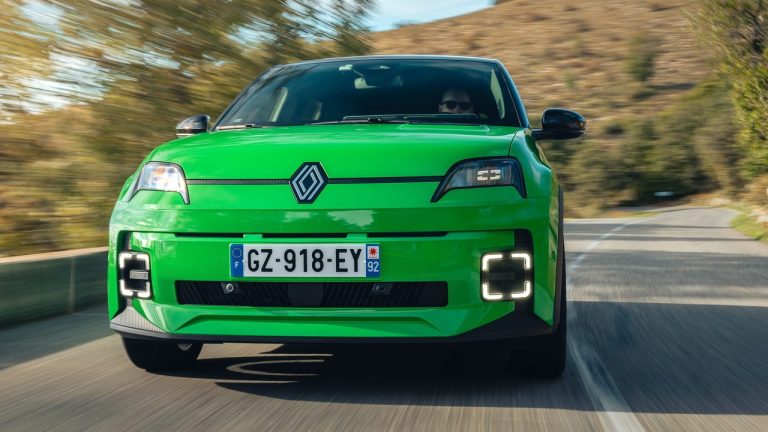
The cold rational left-brain summary is simple. The Renault 5 is an electric supermini, sitting at an impressively good-value part of the price-range curve. A version with 255 miles of WLTP range can be had for £25,000 and it's got most mod cons.
But of course the right brain is in charge here. Just look at it. This is a car you desire rather than merely decide upon. Renault has tapped into a seam of happy memories. The original R5 was a brilliant piece of distinctive product design that gave millions of people sunny memories in the simpler times and roads of the 1970s to 1990s. That covers two generations of drivers, and there's another generation younger than that who were rattling round, unbelted, in the back.
Advertisement – Page continues below
Of course the 5's pitch isn't wholly novel. You can have a Mini Cooper Electric and an electric Fiat 500. Like them, the R5 is more than a slavish visual copy of a sepia-toned memory.
Of course you can go modern: there's Hyundai Inster, definitely. Or the Peugeot e-208 and Vauxhall Corsa Electric, but unless you twist your dealer's arm you'll pay more. There's also the MG4 and BYD Dolphin, which have more space but nowhere near the feelgood.
The decision to re-make one of Renault's 24-carat greatest hits has galvanized everyone in the company to pour their uttermost efforts into it. There are plenty of tales of designers and engineers working most of the way around the clock to perfect it. And when a car has been made by people who love it, it shows.
Let's hope it's not all style and no substance…
Dismiss that thought. Renault is good at EVs, like the Megane and Scenic show. It also has a long history of small electrics, with the Zoe. So we find an efficient and smooth powertrain.
Advertisement – Page continues below
The platform is EV-native, not just an adapted Clio. That means a flat floor, long wheelbase and decent room for a car well under four meters long. It also saves money as the body can be simpler than if it had to hold an engine too. It doesn't need a strong floor because the battery cases strengthens it. There's no need to put in panel shapes and mounting points for the absent fuel tank, gearbox or exhaust. That cuts costs and saves weight. It's 1,450kg even with the bigger battery option.
Underneath there's a multi-link rear suspension and all-disc brakes. All versions have a heat pump.
They have bi-directional charging so you can charge when electricity is cheap in the small hours and sell some back at higher peak-time rates, cutting its cost of living.
Lots of cute details by the look of it.
Right from the front, yes. The four-cornered motif in the headlights winks as you approach. The foglights have the same graphics, and so do the dashboard vents. The rear lights refer to the Mk2 Supercinq R5, the one-piece seat-backs to the Gordini version and the wheel-arches to the mad-arse mid-engined 5 Turbo rally car. The very first R5 had a bonnet vent. Here it's not a vent but a state-of-charge indicator.
Point is, even if you don't remember the old R5 or don't care, the new one stands as an attractive design.
And inside?
The retro goes on. The dash has stitching to emulate the original car's ridged plastic molding and the headlining distantly resembles a rattan basket. The binnacle is a similar rectangular shape to the original's. But of course this time around it houses flat screens.
Materials are mostly pretty lavish, and bright colors add to the cheery air. The driver interface is at heart the one we've praised in other Renaults. Lots of well-placed real switches make it quick and easy to operate with your eyes on the road.
The driver sits low, with no sense of being perched on a battery. It's compact even for a supermini so rear legroom is tight, but not inhumane. For more, click on the Interior tab.
More about the power and battery please.
It's a 52kWh pack using NMC cells at 400V. The motor is an electrically excited synchronous machine (ie no rare-earth elements in magnets in the rotor, but all coils for rotor and stator). In the test car it's 150bhp. Charge time for 15-80 per cent is half an hour. The other time you'll want is the 0-62mph, which is 8.0 seconds.
Soon after launch they'll add a 40kWh version with a motor rated at 120bhp. Range there is 195 miles; same as the larger battery Fiat 500.
How to drive the R5?
We're glad to say the engineers put in just as much love as the designers. It feels light on its feet and nimble. The steering's progressive, and when you load the tires it resists understeer quite playfully.
Yet it's mature too. The ride is taut but well damped at town speed, but on a difficult B-road it lets the car breathe nicely. It's quiet too. More details in the Driving section.
What's the verdict?
“Looking at performance and range, it's right in the sweet spot”
The R5's not the first premium retro EV. It shares with the Mini and Fiat 500 a knowing silhouette, lavish external jewelry and a smart, cheery cabin. But it's bigger than a Fiat 500 and goes further, and it's more practical than the Mini and copes better with bumpy roads.
It's not the cheapest EV either. But looking at performance and range, it's right in the sweet spot, and the bi-directional charging could help subsidize you outlay.
Most of all it feels consistent: as charming to drive as it is to look at and to sit in. Your first love should last.
